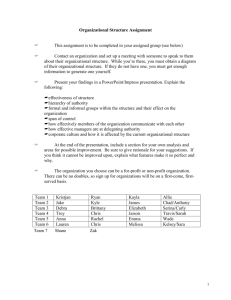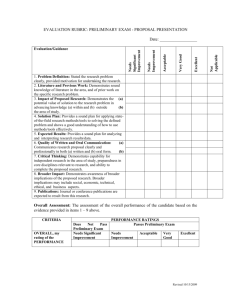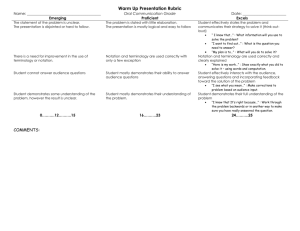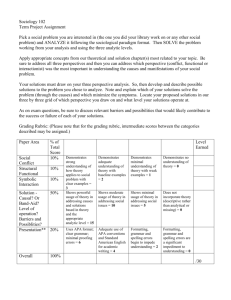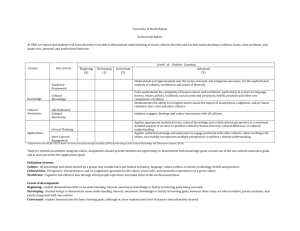Assessment Report – Liisa Yonker The Assessment Institute
advertisement
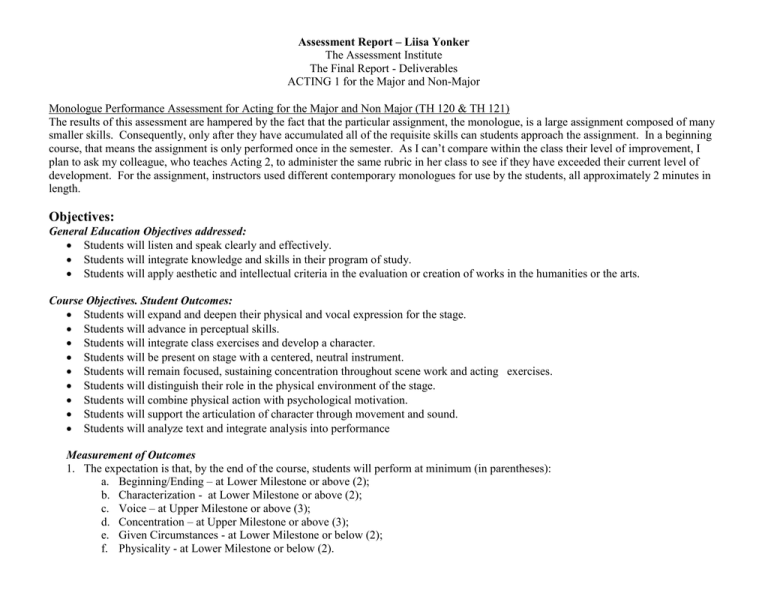
Assessment Report – Liisa Yonker The Assessment Institute The Final Report - Deliverables ACTING 1 for the Major and Non-Major Monologue Performance Assessment for Acting for the Major and Non Major (TH 120 & TH 121) The results of this assessment are hampered by the fact that the particular assignment, the monologue, is a large assignment composed of many smaller skills. Consequently, only after they have accumulated all of the requisite skills can students approach the assignment. In a beginning course, that means the assignment is only performed once in the semester. As I can’t compare within the class their level of improvement, I plan to ask my colleague, who teaches Acting 2, to administer the same rubric in her class to see if they have exceeded their current level of development. For the assignment, instructors used different contemporary monologues for use by the students, all approximately 2 minutes in length. Objectives: General Education Objectives addressed: Students will listen and speak clearly and effectively. Students will integrate knowledge and skills in their program of study. Students will apply aesthetic and intellectual criteria in the evaluation or creation of works in the humanities or the arts. Course Objectives. Student Outcomes: Students will expand and deepen their physical and vocal expression for the stage. Students will advance in perceptual skills. Students will integrate class exercises and develop a character. Students will be present on stage with a centered, neutral instrument. Students will remain focused, sustaining concentration throughout scene work and acting exercises. Students will distinguish their role in the physical environment of the stage. Students will combine physical action with psychological motivation. Students will support the articulation of character through movement and sound. Students will analyze text and integrate analysis into performance Measurement of Outcomes 1. The expectation is that, by the end of the course, students will perform at minimum (in parentheses): a. Beginning/Ending – at Lower Milestone or above (2); b. Characterization - at Lower Milestone or above (2); c. Voice – at Upper Milestone or above (3); d. Concentration – at Upper Milestone or above (3); e. Given Circumstances - at Lower Milestone or below (2); f. Physicality - at Lower Milestone or below (2). Beginning/Ending Characterization Voice Concentration Capstone(4) 100% Upper Milestone (3)75% Student enters and exits with intention, begins only when motivated, and addresses the initial event of the scene/play Student enters and exits with intention, and begins only when motivated, but does not address the initial event of the scene/play 15/5 Demonstrates ability to pursue strong, clear objectives, and character lives believably and honestly within the Given Circumstances 10/7 Speaks with proper support and volume, clear articulation, demonstrates Standard American Speech and voice is expressive and motivated 6/3 Student is focused when speaking and listening and sustains the world of the play throughout the performance 6/14 Demonstrates ability to pursue strong, clear objectives, but character is not consistently believable or honest within the Given Circumstances 15/6 Student identifies and demonstrates who, what, where and when of the world of the Character in performance 5/12 Student identifies and demonstrates 2-3 of the who, what, where and when of the world of the Character in performance Student identifies and demonstrates only 1 of the who, what, where and when of the world of the Character in performance Student unable to identify and demonstrate who, what, where and when of the world of the Character in performance 8/0 Movement is controlled and justified by the text and creatively chosen 10/10 Movement is controlled and justified by the text 6/17 Movement is justified by the text but static and limited in choice 5/4 Movement is excessive or lacks control and not justified by the text 13/8 5/17 8/9 Speaks with proper support and volume, clear articulation, and voice is expressive and motivated Lower Milestone (2) 50% Benchmark (1) 25% Student begins only when motivated but enters or exits without intention Student enters and exits without intention and begins without motivation 4/7 4/5 Occasionally demonstrates ability to pursue strong, clear objectives, but character does not live within the Given Circumstances Does not demonstrate ability to objectives, or live within the Given Circumstances 6/10 5/5 Speaks with proper support, volume and articulation, but voice lacks expression or is unmotivated Voice lacks proper support, volume and articulation, and lacks expression or is unmotivated 8/8 12/16 Student is focused when speaking and listening and sustains the world of the play throughout most of the performance 3/4 Student is unfocused when speaking or listening or fails to sustain the world of the play throughout the performance Student is unfocused when throughout the performance 2/2 7/11 Given Circumstances Physicality 6/3 5/3 # 29M 31N The Results: The sum totals for the Acting for the Major courses TH121 are the first number listed before the slash/ and the second number are the totals for the Non Major TH 120 courses (0/0) below. There were 29 majors and 31 non majors across the 4 courses. 1. Students in the Acting for the Major course TH 121 performed at or above expectations; 2. Students in the Acting for the Non Major course TH 120 also performed at or above expectations and in some instances, higher than the theatre major on certain skills. Moving forward: I plan to ask my colleague, who teaches Acting 2, to administer the same rubric in her class to see if these same students have exceeded their current level of development. In addition, I have decided to include other, more advanced, performance skills within the current rubric. As it currently stands, this rubric only addresses the skills addressed by the Acting 1 (non-major and major) classes. After discussion with my colleagues, we have decided to incorporate this rubric, with more advanced skills included, across all of the Acting courses. Accordingly, the following classes will use the revised rubric to assess student learning: TH 120- Acting 1 non-major (all sections) TH 121 – Acting 1 major (all sections) TH 221 – Acting 2 I have attached a revised rubric at the end of this document. Students in the Acting 1 courses will still be expected to perform at the levels previously listed. The only addition will be a more advanced skill-set in the Upper Milestone and Capstone columns. This change is made in order to accommodate the more advanced student encountered in the Acting 2 course. Capstone(4) 100% Upper Milestone (3)75% Student enters and exits with intention, begins only when motivated, and addresses the initial event of the scene/play Student enters and exits with intention, and begins only when motivated, but does not address the initial event of the scene/play Student begins only when motivated but enters or exits without intention Student enters and exits without intention and begins without motivation Characterization Demonstrates ability to pursue strong, clear objectives, and character lives believably and honestly within the Given Circumstances Demonstrates ability to pursue strong, clear objectives, but character is not consistently believable or honest within the Given Circumstances Occasionally demonstrates ability to pursue strong, clear objectives, but character does not live within the Given Circumstances Does not demonstrate ability to objectives, or live within the Given Circumstances Voice Speaks with proper support and volume, clear articulation, demonstrates Standard American Speech and voice is expressive and motivated by text Student is focused when speaking and listening, sustains the world of the play throughout the performance and maintains 4th wall throughout Speaks with proper support and volume, clear articulation, and voice is expressive and motivated Speaks with proper support, volume and articulation, but voice lacks expression or is unmotivated Voice lacks proper support, volume and articulation, and lacks expression or is unmotivated Student is focused when speaking and listening and sustains the world of the play throughout most of the performance Student is unfocused when speaking or listening or fails to sustain the world of the play throughout the performance Student is unfocused when throughout the performance Given Circumstances Student identifies and demonstrates who, what, where and when of the world of the Character in performance and makes varied, specific and bold choices. Student identifies and demonstrates 2-3 of the who, what, where and when of the world of the Character in performance Student identifies and demonstrates only 1 of the who, what, where and when of the world of the Character in performance Student unable to identify and demonstrate who, what, where and when of the world of the Character in performance Physicality Movement is controlled and justified by the text, creatively chosen and bold Movement is controlled and justified by the text Movement is justified by the text but static and limited in choice Movement is excessive or lacks control and not justified by the text Beginning/Ending Concentration Lower Milestone (2) 50% Benchmark (1) 25% # 29M 31N Text Analysis Student demonstrates an understanding of the subtext of the monologue, uses the text to create visual images and is “on the word” throughout. Student demonstrates an understanding of the subtext of the monologue, uses the text to create visual images but is occasionally, not “on the word” Student demonstrates an understanding of the subtext of the monologue, does not consistently use the text to create visual images and is occasionally, not “on the word” Student fails to demonstrate an understanding of the subtext of the monologue, does not consistently use the text to create visual images and is occasionally, not “on the word”
